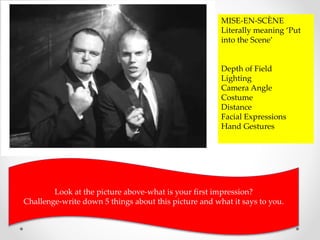Media lesson-Representation
- 1. Look at the picture above-what is your first impression? Challenge-write down 5 things about this picture and what it says to you. MISE-EN-SCÈNE Literally meaning ‘Put into the Scene’ Depth of Field Lighting Camera Angle Costume Distance Facial Expressions Hand Gestures
- 2. Representation Lesson 1 Consider the meaning of ‘representation’ and the ways print media construct images to represent certain individuals and groups.
- 3. What is representation? Representation is the constructed and mediated presentation of people, things, ideas, places etc. and The process by which the media present the ‘real world’ (Rayner) In other words, everything in the media is a representation – everything we see is being represented.
- 6. All media texts are constructed. For example, a model on the front of a magazine may be airbrushed and digitally enhanced; s/he will not look the same as if we saw them in ‘reel life’. https://www.youtube.com/watch?v=zRlpIkH3b5I Men: https://www.youtube.com/watch?v=-_I17cK1ltY
- 7. This digitally enhanced image of Rachel Weisz was used to advertise an anti-wrinkle cream however it was banned as being misleading.
- 8. The Process of Construction An image may appear to be presenting us with a factual image but it has been through a process of construction: *The photographer has selected his/her position, lens, angle, exposure and framing before taking the picture. *The picture editor will decide if the image needs to be cropped, enhanced or altered before inclusion. *An editor will choose which, of the many available photos of the image, will be the one chosen for inclusion and, importantly at this stage, the images which do not meet the needs of the text will be rejected. Even then, further mediation takes place: *Will the photo be large or small? *Where will the image be placed? Caption/Headline/Close to another photo?
- 9. *How did the process of construction change the meaning of this image and the effect on the reader? Remember to consider depth of field/lighting/camera angle/composition etc…
- 10. Technical codes and editing in audio-visual texts is another way in which representations are constructed; taking a photo of a group of teenagers using low key lighting may make them look more dangerous.
- 11. Stereotypes • Media texts use stereotypes to give out messages quickly to audiences. • Stereotypes work by over-emphasising certain features of a person, for example the moodiness and unreasonable behaviour of a teenager. • The audience will recognise certain stereotypes and know how they will behave. For example, the cheeky teenager in a soap opera, or the career woman in an advertisement. • Not all stereotypes are negative. ‘Irish people are friendly’ is an example of a positive stereotype.
- 12. How are teenagers represented in these images? How have the images been edited to fuel the stereotype? Different audiences will respond to representations in different ways. How many different people respond to these?
- 13. How are young people and women presented in these two texts?
- 14. Technical codes and digital enhancing have been used in this advert. The model’s skin is perfect, there are no shadows, lines or blemishes. It is an unrealistic representation of a woman High key lighting has been used to make her look even more perfect. The blue of her eyes has been made brighter and more shiny. Her eye lashes have been made longer digitally in order to persuade the audience that the mascara did this. They may even buy the product,
- 15. In this film poster, the aim is to make the young people look dangerous and intimidating. This has been done through: • Technical codes-the lighting is low key and there are shadows on faces to give clues to characters. • Visual codes-the colours are muted, giving the poster a more urban feel to it. There are also suggestions of an urban setting. • Iconography-the clothing is typical of city teenagers and the use of the hoodie suggests a stereotype audiences will recognise. The baseball bat suggests violence will be an element of the film. • Mode of address-the characters are looking directly at the audience and their expressions are challenging and a bit scary.
- 16. Questions to ask when analysing representation • WHO or WHAT is being represented? • How is the representation created? • WHO has created the representation? • WHY is the representation created in that way? What Is the intention? • WHAT is the effect of the representation?















